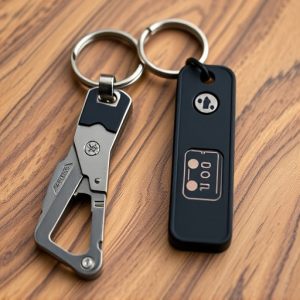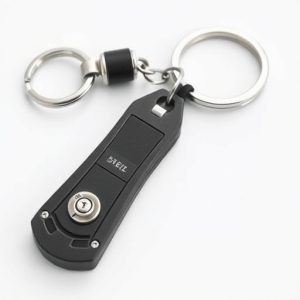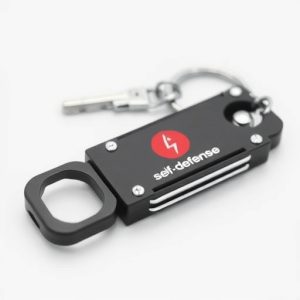Designing Safe & Legal Defense Keychains: Tips for Compliant Gripping
Designing a metal defense keychain requires understanding and adhering to the Prohibited Keychain We…….
Designing a metal defense keychain requires understanding and adhering to the Prohibited Keychain Weapons List to avoid legal consequences. Key considerations include avoiding sharp blades, locking mechanisms, or designs capable of causing serious injury, as these are often banned. Instead, focus on rounded edges, ergonomic shapes, durable materials like stainless steel or titanium, and ensuring comfort for safe and effective use. Personalization is encouraged but must stay within legal parameters, focusing on functionality without prohibited features. Staying informed about local regulations ensures the keychain serves its purpose while maintaining legal integrity.
In today’s world, self-defense is a top priority. One popular and portable option is the defensive keychain grip, but it’s crucial to understand the legal limitations surrounding these tools. This article navigates the intricate details of prohibited keychain weapons, offering valuable insights for design enthusiasts. We explore essential tips on creating safe and legal grips, from materials to customization, ensuring you stay within regulatory boundaries. Discover how to craft a unique defense keychain while avoiding common pitfalls listed in the Prohibited Keychain Weapons List.
- Understanding Legal Limitations: What Constitutes a Prohibited Keychain Weapon?
- Design Considerations for Safe and Legal Keychain Gripping
- Materials and Construction: Choosing the Right Components
- Ergonomics and Comfort: Ensuring a Secure Grip Without Discomfort
- Customization Tips: Making Your Defense Keychain Unique While Adhering to Regulations
Understanding Legal Limitations: What Constitutes a Prohibited Keychain Weapon?
When designing a metal defense keychain, it’s crucial to understand the legal limitations governing what constitutes a prohibited keychain weapon. Different jurisdictions have varying definitions and restrictions on self-defense tools, especially when they can be easily concealed as keychains. In many places, laws specifically prohibit certain types of keychains with sharp blades or spikes designed for offensive purposes.
The list of prohibited keychain weapons typically includes those with blades longer than a certain threshold (often around 2.5-3 inches), as well as any that have a locking mechanism or are capable of causing serious injury. It’s also important to avoid designs that could be easily modified to hold a larger blade or become a dangerous weapon. Staying informed about local regulations is key, as the legal boundaries can shift, and misclassification can lead to legal consequences.
Design Considerations for Safe and Legal Keychain Gripping
When designing a keychain grip, safety and legality should be paramount considerations. Keychains designed for defensive purposes must adhere to stringent regulations, aiming to avoid their misuse as prohibited weapons. The Prohibited Keychain Weapons List outlines specific characteristics that render a keychain illegal, focusing on sharp edges, bladed components, or any design that could function as a weapon. Therefore, designers must strive to incorporate rounded edges, ergonomic shapes, and materials that minimize the risk of injury while emphasizing the primary function of unlocking doors.
Moreover, legal compliance involves understanding local and national laws regarding self-defense tools. Keychain grips should be designed with a clear purpose for defense, such as deterring or temporarily incapacitating an attacker, without becoming aggressive or causing undue harm. This balance ensures that the keychain remains a practical and legal defense option for those seeking personal security while adhering to ethical guidelines and avoiding potential legal repercussions.
Materials and Construction: Choosing the Right Components
When designing a metal defense keychain, selecting the appropriate materials and construction techniques is paramount. The key components include high-quality metals like stainless steel or titanium for durability and strength. These materials should be chosen based on their resistance to corrosion and ability to withstand frequent use, ensuring the keychain can endure the rigors of everyday carry without compromising safety.
The design must also comply with relevant laws and regulations, avoiding any features that might resemble prohibited keychain weapons listed by local authorities. This includes steering clear of sharp edges or points that could cause injury if used as a striking tool. Proper construction involves seamless welds and precise machining to ensure the keychain’s structural integrity while adhering to safety standards, making it an effective yet legal self-defense tool.
Ergonomics and Comfort: Ensuring a Secure Grip Without Discomfort
When designing a metal defense keychain, ergonomics and comfort should be top priorities to ensure it’s not just effective but also safe and user-friendly. The grip should fit comfortably in the hand, allowing for a secure hold without causing strain or discomfort. This is especially important as users might need to rely on the keychain for self-defense in unexpected situations. Avoid designs with sharp edges or uncomfortable shapes that could lead to injuries during use.
Consider the size and weight of the keychain as well; it should be lightweight enough to not add significant bulk to your keys or cause fatigue when carrying, yet robust enough to provide sturdy protection. Moreover, the grip should accommodate different hand sizes, making it accessible for a wide range of users. Remember, a prohibited keychain weapon list exists for a reason—ensuring your design does not fall into that category by prioritizing safety and comfort will help create a responsible and effective self-defense tool.
Customization Tips: Making Your Defense Keychain Unique While Adhering to Regulations
Adding a personal touch to your defense keychain can make it more meaningful and distinctive, but it’s crucial to stay within legal boundaries. Customization should enhance its functionality without incorporating items from the prohibited keychain weapons list. Consider unique engravings or laser-cut designs that reflect your interests or values while adhering to local laws. You can also experiment with different materials like textured metals or incorporate subtle glow-in-the-dark elements for added security features.
Remember, customization is about expressing yourself without compromising safety and legality. Stay informed about regional regulations regarding self-defense tools to ensure your keychain remains a practical and compliant accessory.
When crafting your metal defense keychain, it’s paramount to balance functionality with legal constraints. By understanding what constitutes a prohibited keychain weapon and adhering to design, material, ergonomic, and customization tips discussed here, you can create a unique self-defense tool that remains within regulatory limits. Remember, knowledge of the law and thoughtful consideration are key to enjoying your personalized defense accessory safely and legally.


